
The light brown apple moth is a leafroller moth belonging to the lepidopteran family Tortricidae.

Archips podana, the large fruit-tree tortrix, is a moth of the family Tortricidae. The species was first described by Giovanni Antonio Scopoli in his 1763 Entomologia Carniolica. It is found in Europe, Asia from Anatolia to Japan and is an introduced species in North America.
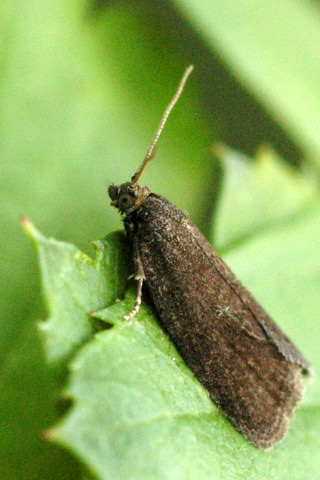
Aphelia viburnana, the bilberry tortrix, is a moth of the family Tortricidae. It is found in Europe, from Portugal and Great Britain to the Ural Mountains, Siberia and Mongolia, further east to the Russian Far East.

Rhyacionia buoliana, the pine shoot moth, is a moth of the family Tortricidae. It is native to North Africa, North Asia, and Europe, and invasive in North America and South America.

Lobesia botrana, the European grapevine moth or European grape worm, is a moth of the family Tortricidae.
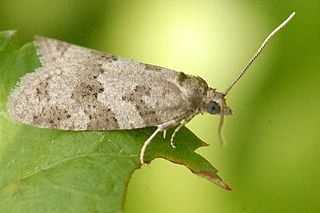
Cnephasia stephensiana, the grey tortrix, is a moth of the family Tortricidae. It is found in the Palearctic realm, and has also been recorded from Canada.
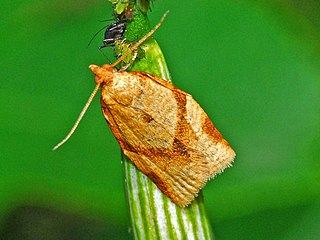
Clepsis consimilana, the privet tortrix, is a moth of the family Tortricidae.

Ditula angustiorana, the red-barred tortrix, is a moth of the family Tortricidae found in Africa, Asia, Europe and North Africa. Other common names are the fruit-tree tortrix and the vine tortrix. The moth was first described by Adrian Hardy Haworth in 1811.
Archips alberta is a species of moth of the family Tortricidae first described by James Halliday McDunnough in 1923. It is found in North America, where it has been recorded across boreal Canada, south through the mountains to Utah. The habitat consists of coniferous forests.
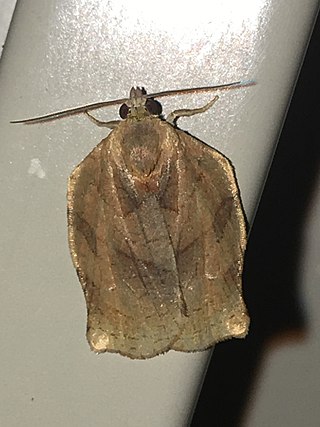
Archips purpuranus, the omnivorous leafroller moth, is a species of moth of the family Tortricidae. It is found in most of eastern North America.
Argyrotaenia quadrifasciana, the four-lined leafroller moth, four-banded leafroller or lesser all-green leafroller, is a species of moth of the family Tortricidae. It is found in North America, where it has been recorded from Nova Scotia to West Virginia, west to Arkansas and north to Alberta. The habitat consists of orchards and shrubby areas.
Argyrotaenia occultana, the fall spruce needle moth, is a moth of the family Tortricidae. The species was first described by Thomas Nesbitt Freeman in 1942. It is found in North America, where it has been recorded from British Columbia north to Yukon and Northwest Territories, east to Newfoundland and south to Kentucky and Oregon. The habitat consists of spruce forests.
Choristoneura zapulata, the zapulata moth, is a moth of the family Tortricidae. The species was first described by Robinson in 1869. It is found in North America, where it has been recorded from British Columbia to Quebec, south to California, Illinois and Pennsylvania.

Clepsis peritana, the garden tortrix or strawberry garden tortrix, is a species of moth of the family Tortricidae. It is found in Spain, Cuba, as well as North America, where it has been recorded from southern Canada throughout the United States.
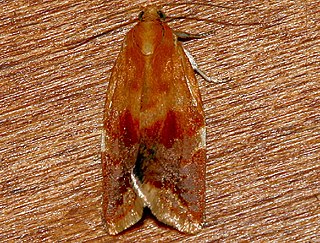
Clepsis persicana, the white triangle tortrix or the green needleworm, is a species of moth of the family Tortricidae. It is found in North America, where it has been recorded from Alaska and British Columbia to Newfoundland and south to Virginia and west to California. The habitat consists of coniferous and mixed coniferous forests.

Clepsis virescana, the light brown apple moth, is a species of moth of the family Tortricidae. It is found in North America, where it is widespread in southern Canada and most of the United States. The habitat consists of shrubby open areas and aspen parkland.
Pandemis canadana, the green aspen leaftier, is a moth of the family Tortricidae. The species was first described by William D. Kearfott in 1905. It is found in North America, where it has been recorded from British Columbia to Nova Scotia, south to Colorado, Illinois and Maine. The habitat consists of deciduous forests and shrubs.
Acleris busckana is a species of moth of the family Tortricidae. It is found in North America, where it has been recorded from Maine, Manitoba, Massachusetts, New Brunswick, New Hampshire, Ohio, Ontario, Quebec and West Virginia.
Acleris semiannula is a species of moth of the family Tortricidae. It is found in North America, where it has been recorded from Alberta, British Columbia, Illinois, Maine, Maryland, Mississippi, New Brunswick, New York, Ohio, Ontario, Pennsylvania, Quebec, South Carolina, West Virginia and Wisconsin.
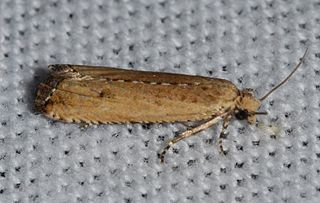
Bactra verutana, the javelin moth, is a species of moth of the family Tortricidae. It is found in North America, where it has been recorded from Florida, Texas, Mississippi, North Carolina, Indiana, Missouri, Ontario, Alberta, Quebec and Labrador. It is also found in Cuba, Mexico, Panama, Paraguay, Puerto Rico, Mozambique and South Africa. The habitat consists of prairies, aspen parkland, foothills and mixed wood areas.













